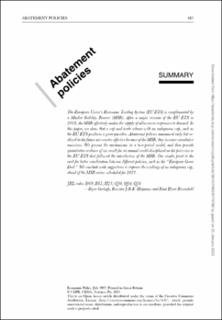| dc.contributor.author | Gerlagh, Reyer | |
| dc.contributor.author | Heijmans, Roweno | |
| dc.contributor.author | Rosendahl, Knut Einar | |
| dc.date.accessioned | 2022-04-11T11:19:45Z | |
| dc.date.available | 2022-04-11T11:19:45Z | |
| dc.date.created | 2022-01-05T14:08:41Z | |
| dc.date.issued | 2021 | |
| dc.identifier.citation | Economic Policy. 2021, 36(107), 485-522. | en_US |
| dc.identifier.issn | 0266-4658 | |
| dc.identifier.uri | https://hdl.handle.net/11250/2990910 | |
| dc.description.abstract | The European Union’s Emissions Trading System (EU ETS) is complemented by a Market Stability Reserve (MSR). After a major revision of the EU ETS in 2018, the MSR effectively makes the supply of allowances responsive to demand. In this paper, we show that a cap-and-trade scheme with an endogenous cap, such as the EU ETS produces a green paradox. Abatement policies announced early but realized in the future are counter-effective because of the MSR, they increase cumulative emissions. We present the mechanisms in a two-period model, and then provide quantitative evidence of our result for an annual model disciplined on the price rise in the EU ETS that followed the introduction of the MSR. Our results point to the need for better coordination between different policies, such as the “European Green Deal.” We conclude with suggestions to improve the workings of an endogenous cap, ahead of the MSR review scheduled for 2021. | en_US |
| dc.language.iso | eng | en_US |
| dc.title | An Endogenous Emission Cap Produces a Green Paradox | en_US |
| dc.type | Journal article | en_US |
| dc.type | Peer reviewed | en_US |
| dc.description.version | publishedVersion | en_US |
| dc.source.pagenumber | 485-522 | en_US |
| dc.source.volume | 36 | en_US |
| dc.source.journal | Economic Policy | en_US |
| dc.identifier.doi | 10.1093/epolic/eiab011 | |
| dc.identifier.cristin | 1975244 | |
| dc.relation.project | Norges forskningsråd: 209698 | en_US |
| dc.relation.project | Norges forskningsråd: 280987 | en_US |
| cristin.ispublished | true | |
| cristin.fulltext | postprint | |
| cristin.fulltext | original | |
| cristin.qualitycode | 1 | |
